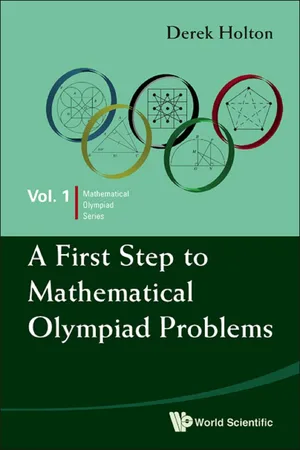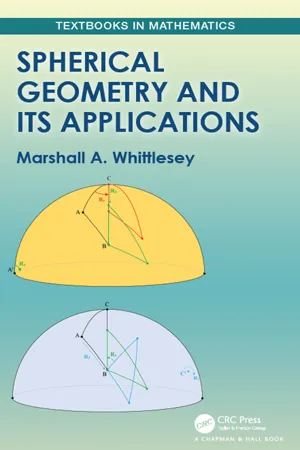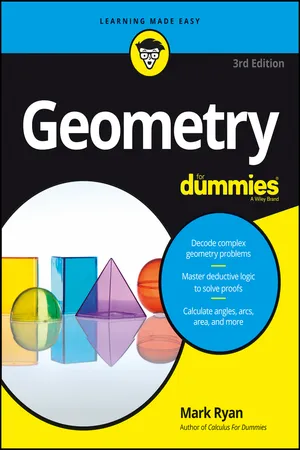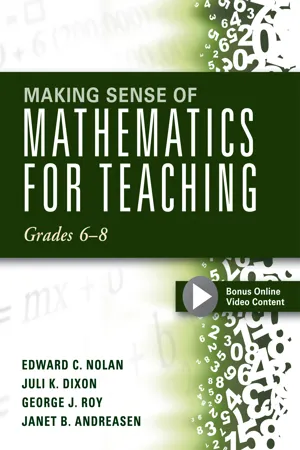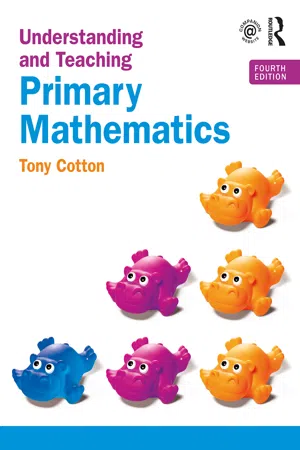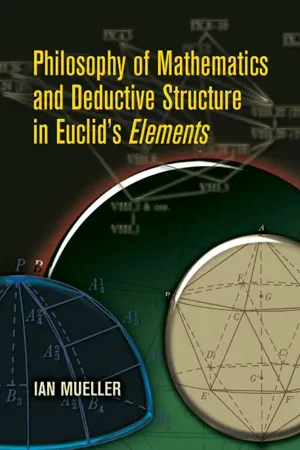Mathematics
Parallelograms
Parallelograms are quadrilaterals with opposite sides that are parallel and equal in length. The opposite angles of a parallelogram are also equal. Additionally, the diagonals of a parallelogram bisect each other. These properties make parallelograms useful in various mathematical and geometric applications, such as calculating areas and solving problems involving vectors.
Written by Perlego with AI-assistance
Related key terms
8 Key excerpts on "Parallelograms"
- eBook - ePub
- Derek Holton(Author)
- 2009(Publication Date)
- WSPC(Publisher)
5.3. Rectangles and ParallelogramsA rectangle is a four-gon (four-sided figure) all of whose angles are right angles and whose opposite sides are equal in length.We show a rectangle in Figure 5.7 . Obviously a square is a special type of rectangle.Exercises11. Do rectangles tessellate the plane? 12. Did Escher ever start one of his “tessellations” from rectangles? 13. Are rectangles self-replicating? 14. Is every shape that tessellates the plane a self-replicating shape? 15. Can you square a rectangle (i) with squares of equal size; (ii) with squares of unequal size; (iii) with squares which are all of different sizes;(iv) with m squares;(v) with one square each of side length 1,2,…, n? 16. Divide a rectangle of side lengths 6 and 9 into squares of side length one. How many squares are there?Generalise. 17. Can you rectangle a rectangle? That is, can you make up a rectangle from smaller rectangles? In what different ways can this be done? 18. Take any two rectangles and plonk them down anywhere in the plane. In how many different shapes will the two rectangles intersect?So now we get to Parallelograms. A parallelogram is a gram made of parallels. Take two pairs of parallel lines. The four-sided figure (“gram”) they make is a parallelogram (see Figure 5.8 ). So a parallelogram is a foursided figure with both pairs of opposite sides parallel.Figure 5.8.We represent the parallel property by the insertion of arrows. Because the top and bottom sides of the parallelogram in Figure 5.8 are parallel we put an arrow on each of them. Because the left and right sides of the parallelogram are parallel (but not parallel to the top and bottom sides) we put two arrows on each of them.In general the angles between adjacent sides of a parallelogram are not equal. However, when they are we get a rectangle or a square. Squares and rectangles are just special Parallelograms.Exercise19. Repeat Exercises 11-18 with the words “rectangle” and “square” replaced everywhere by “parallelogram”. - eBook - ePub
- Marshall Whittlesey(Author)
- 2019(Publication Date)
- Chapman and Hall/CRC(Publisher)
median of the trapezoid. The length of the midline is the arithmetic mean (half of the sum) of the length of the bases.Let O be a point in a plane and r a positive real number. The circle with center O and radius r is the set of all points in the plane at distance r from O.We shall need the following lemma when we discuss areas in §7.Lemma 1.4 Suppose ℓ is a line in a plane, s is a line segment, and M is a point on s. Suppose that the line perpendicular to s at M intersects ℓ in a point N. Let a1 be the length of s, b1 the distance from M to ℓ, a2 the length of the projection of s to ℓ, and b2 the length of the segment from M to N. Then a1 b1 = a2 b2 .Figure 1.1: Lemma 1.4.Proof. Because the point N of intersection exists, the line containing s cannot be perpendicular to ℓ. If s is parallel to ℓ, then a1 = a2 and b1 = b2 and so a1 b1 = a2 b2 by multiplying these equations. If s is not parallel to ℓ, then let A be the endpoint of s which is closer to ℓ and let B be the other endpoint. Let A′, B′, and M′ be the projections of A, B, and M to ℓ and let C be the projection of B to. Since s is not parallel to ℓ, the points A, B, and C are not collinear; hence, they form a triangle. Similarly, M, M′, and N form a triangle. We claim that ΔABC ~ ΔNMM′. To see this, note that the triangles have a right angle at C and M′. We have that ∠M′MN is complementary to ∠M′MA sinceA↔A ′is perpendicular toM N↔at M. Also, ∠M′MA is congruent to ∠B′BA as corresponding angles of the parallel linesA B↔andB↔B ′(these lines being parallel since both are perpendicular to ℓ). Since C is the projection of B toM↔M ′, and A′ and B′ are the projections of A and B to ℓ, respectively, the quadrilateral CA′B′B is a rectangle. Thus ∠CBB′ is right, and so ∠B′BA and ∠CBA are complementary. Summing up what we have found, m∠M′MN =A↔A ′π 2− m∠M′MA =π 2− m∠B′BA = m∠CBA. Thus in ΔABC and ΔNMM′, two pairs of corresponding angles are congruent. We conclude that these triangles are similar. Since the ratios of the lengths of corresponding sides are the same, AB/MN = BC/MM′, i.e., a1 /b2 = a2 /b1 , or a1 b1 = a2 b2 - eBook - ePub
- Mark Ryan(Author)
- 2016(Publication Date)
- For Dummies(Publisher)
Five ways to prove that a quadrilateral is a parallelogram: There are five different ways of proving that a quadrilateral is a parallelogram. The first four are the converses of parallelogram properties (including the definition of a parallelogram). Make sure you remember the oddball fifth one — which isn’t the converse of a property — because it often comes in handy:- If both pairs of opposite sides of a quadrilateral are parallel, then it’s a parallelogram (reverse of the definition). Because this is the reverse of the definition, it’s technically a definition, not a theorem or postulate, but it works exactly like a theorem, so don’t sweat this distinction.
- If both pairs of opposite sides of a quadrilateral are congruent, then it’s a parallelogram (converse of a property).To get a feel for why this proof method works, take two toothpicks and two pens or pencils of the same length and put them all together tip-to-tip; create a closed figure, with the toothpicks opposite each other. The only shape you can make is a parallelogram.
- If both pairs of opposite angles of a quadrilateral are congruent, then it’s a parallelogram (converse of a property).
- If the diagonals of a quadrilateral bisect each other, then it’s a parallelogram (converse of a property).Take, say, a pencil and a toothpick (or two pens or pencils of different lengths) and make them cross each other at their midpoints. No matter how you change the angle they make, their tips form a parallelogram.
- If one pair of opposite sides of a quadrilateral are both parallel and congruent, then it’s a parallelogram (neither the reverse of the definition nor the converse of a property).Take two pens or pencils of the same length, holding one in each hand. If you keep them parallel, no matter how you move them around, you can see that their four ends form a parallelogram.
The preceding list contains the converses of four of the five parallelogram properties. If you’re wondering why the converse of the fifth property (consecutive angles are supplementary) - eBook - ePub
Making Sense of Mathematics for Teaching Grades 6-8
(Unifying Topics for an Understanding of Functions, Statistics, and Probability)
- Edward C. Nolan, Juli K. Dixon(Authors)
- 2016(Publication Date)
- Solution Tree Press(Publisher)
figure 5.14 ), it must be perpendicular in order to use the properties of a rectangle to create a formula for the area of a parallelogram.Figure 5.14: Cutting a parallelogram in different ways.Once the area of a parallelogram is determined, areas of other shapes can be examined. The formulas for the areas of triangles, trapezoids (like the task in figure 5.1 , page 105 ), other polygons, and circles can be examined. Take a moment to consider the area task in figure 5.15 .Create an expression to represent the area of each shape using derivations that start with the formula for the area of a rectangle (and therefore a parallelogram as well).Figure 5.15: Area of triangle, polygon, and circle task.How did you go about finding the area of each of these shapes? Examine the triangle first. How can this triangle be related to a parallelogram? If you were to rotate this triangle 180° about the midpoint of , what would happen? Think back to the task in figure 5.1 (page 105 ) when the trapezoid was rotated to create a parallelogram. Figure 5.16 shows what happens to the pre-image and image when this rotation occurs.What happens when you rotate this triangle 180°? When the original triangle is rotated and the pre-image and image are considered together, a parallelogram is created. The rotated triangle is labeled based on the correspondence to the vertices of the pre-image. The point A ' is the rotated location of A in the image. This is a way to clearly describe the effect of the rotation on the pre-image. Due to the rotation, the point C could also be labeled B ' and the point B could also be labeled C '; however, relabeling these points is not necessary for this exploration. The area of the parallelogram is the base times the height of the parallelogram. If you consider the base of the parallelogram to be , then the height of the parallelogram would be the perpendicular distance from point C to that base. This is the same as the height of the original triangle. Since the area of the parallelogram would be the base times the height and the parallelogram is made up of two identical triangles, the original triangle would be half the area of the parallelogram, orAtri= ½bh . This is true whether the original triangle is acute, obtuse, or right. The triangle explored in this discussion was acute; composite shapes from obtuse and right triangles are shown in figure 5.17 - eBook - ePub
- Tony Cotton(Author)
- 2020(Publication Date)
- Routledge(Publisher)
oblong is a rectangle that isn’t a square. Parallelogram A quadrilateral with opposite sides parallel Trapezium A quadrilateral with only one pair of parallel sides Kite A quadrilateral with adjacent sides (i.e. sides that are joined at a point) of equal lengthPortfolio task 9.3
Try this activity – the folding helps you understand ideas of symmetry, and the surprises when you unfold the shape support you in noticing the properties of the shapes. Children find it motivating too as it develops their skills of visualisation because they have to try to visualise the shape that will emerge when they unfold the paper.Take a piece of A4 paper and make one fold anywhere. You do not have to fold it in half. Make a cut so that you form two shapes out of the piece of paper. Sketch the two shapes that you have made and name them. Can you find ways to fold and cut the paper so that you make a square, a rhombus , a rectangle, a parallelogram , a trapezium and a kite?Three-dimensional shapes can also be classified in several ways.Prismsandpyramidsare sometimes confused. I remember a 14-year-old pupil of mine describing the difference as, ‘A prism is where you find naughty people and a pyramid is where you find dead people’. The actual difference is to do with the cross-section. You can slice a prism at any point, parallel to the face at the end, and you will always get the same cross-section, whereas if you slice a pyramid you will get different sizes of the same shape.Two prisms you might recognise are acubeand a cuboid. The most common 3D shapes are shown as follows. One way of classifying 3D shapes is by the numbers offaces,edgesand vertices (singularvertex - Ian Mueller(Author)
- 2013(Publication Date)
- Dover Publications(Publisher)
VI, 1 does not, of course, give the full strength of the formulas for triangles and Parallelograms. For Parallelograms the closest approximation to this full strength expressed in terms of proportionality might be “Parallelograms are to one another as the products of their bases and heights,” or, since a parallelogram is equal to the rectangle with the same base and height, “Rectangles are to one another as the products of two adjacent sides of each.” It is not necessary to concern ourselves further with triangles, since any result for Parallelograms is easily extended to triangles using I,34. The trouble with either of the formulations just given is that they use the notion of the product of two straight lines, a notion presupposing most of the conceptual apparatus implicit in the traditional formulas. One might identify the product of two straight lines with the rectangle contained by them. However, this identification turns the proportionality between Parallelograms and the products of their bases and heights into a trivial consequence of I,36, and the proportionality between rectangles and the products of two of their adjacent sides into a vacuous assertion of the form (x, y) = (x, y). In discussing VIII,5 I pointed out that the compounding of ratios is an analogue of the multiplication of fractions, even though Euclid’s treatments of compounding and of duplicating suggest no awareness of the connection. Using the notion of compounding one can approximate the formula for the area of a parallelogram with the law VIB Parallelograms are to one another in the ratio compounded of the ratio of their heights and the ratio of their bases. Although Euclid does not prove this law, he does prove VI,23 Equiangular Parallelograms have to one another the ratio compounded of [the ratios of] their sides. As Heath (vol. II, p- eBook - ePub
Military schools and courses of instruction in the science and art of war,
in France, Prussia, Austria, Russia, Sweden, Switzerland, Sardinia, England, and the United States. Drawn from recent official reports and documents. Revised Edition
- (Author)
- 2013(Publication Date)
- Perlego(Publisher)
the other sides, the square of the first side will be equal to the sum of the squares of the other two, minus twice the product of the side on which the perpendicular is let fall by the distance of that perpendicular from the angle opposite to the first side, if the angle is acute, and plus twice the same product, if this angle is obtuse. Of polygons. Parallelograms.—Properties of their angles and of their diagonals. Division of polygons into triangles.—Sum of their interior angles.—Equality and construction of polygons. Similar polygons.—Their decomposition into similar triangles.—The right lines similarly situated in the two polygons are proportional to the homologous sides of the polygons.—To construct, on a given line, a polygon similar to a given polygon.—The perimeters of two similar polygons are to each other as the homologous sides of these polygons. Of the right line and the circumference of the circle. Simultaneous equality of arcs and chords in the same circle.—The greatest arc has the greatest chord, and reciprocally.—Two arcs being given in the same circle or in equal-circles, to find the ratio of their lengths. Every right line drawn perpendicular to a chord at its middle, passes through the centre of the circle and through the middle of the arc subtended by the chord.—Division of an arc into two equal parts.—To pass the circumference of a circle through three points not in the same right line. The tangent at any point of a circumference is perpendicular to the radius passing through that point. The - eBook - ePub
- Gary Thorne(Author)
- 2015(Publication Date)
- Crowood(Publisher)
To construct a square using a compass, draw the base of AB of the required square. Erect the perpendiculars at A and B, then placing the compass on A, establish AB and draw a quarter arc to intersect the perpendicular at D. In order to confirm correct intersections, place the compass on B, using the established length AB, plot a quarter arc to intersect the perpendicular at C (not shown).A rectangle is a four-sided figure with equal opposite sides and its angles all right angles. Opposite sides and all angles being equal; diagonals from the corners are equal yet where they intersect the angles are not 90 degrees.A quadrilateral form is bound by four straight lines; when opposite sides are parallel it is a parallelogram. A quadrilateral can be a:1. Rectangle: all angles are at right angles. 2. Square: if the sides are equal. 3. Rhombus: if all sides are equal yet angles are not right angles. 4. Trapezium: only two of the sides are parallel. Quadrilaterals and polygons.PolygonsPolygons are plane figures consisting of more than four sides. When sides are equal they are called regular polygons. Polygons include:
QUADRANTS AND CIRCLES5. Pentagon: five sides 6. Hexagon: six sides 7. Heptagon: seven sides 8. Octagon: eight sides. The quadrant is a segment of a circle with a right angle at centre of the curve. The half circle has the radius of the circle forming the diameter line. The circle has a centre point. Radials can be drawn from the right angle point of a quadrant at degrees of 15, 30, 45, 60, 75 and 90 to form a quarter circle. This is established through using 45 degree and 30/60 degree set squares and a T-square.A quadrant, half circle and circle.ANGLES An acute angle is less than a 90 degree angle. An obtuse angle is greater than 90 degrees. It must be less than 180 degrees.A quadrant.The supplement of an angle is the remaining degrees which when added equals 180 degrees. ABC (overleaf) is 110 degrees. Therefore the supplement to this angle is 70 degrees. The complement of an angle is the remaining degrees which when added together form 90 degrees. 70 degrees and 20 degrees = 90 degrees.
Index pages curate the most relevant extracts from our library of academic textbooks. They’ve been created using an in-house natural language model (NLM), each adding context and meaning to key research topics.
